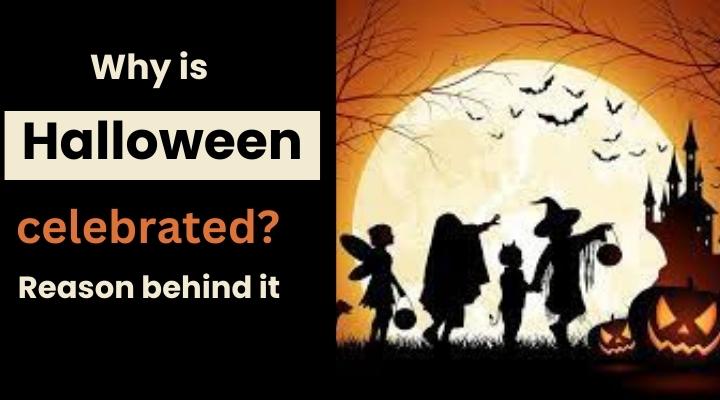Why is Halloween celebrated? – Reason behind it
Many people love Halloween because of the spooky costumes, candy, and decorations. But do you know why we celebrate Halloween? In this article, we will learn about the interesting history and reasons behind this slightly eerie holiday. Halloween is celebrated on the night of October 31st and is known for its unique mix of playful fright and community fun. Samhain marked the end of the harvest season and the beginning of the dark, cold winter, a time often associated with death.
Halloween – A Time for Spooks and Scares
The Celtic Connection
The Celts, living in what’s now Ireland, the UK, and northern France, celebrated Samhain to honor ancestors and prepare for the harsh winter. They believed the boundary between the living and dead blurred on October 31st. To ward off malevolent spirits, they lit bonfires and donned animal skin costumes, confusing the spirits and protecting the living. Bonfires served religious and divinatory purposes as they offered sacrifices and made predictions during Samhain.
Christianity and All Saints’ Day
People celebrate Halloween today, and Christianity has had a big influence on it. In the early 7th century, Pope Boniface IV introduced All Saints’ Day (or All Hallows’ Day) on November 1st to honor Christian saints and martyrs without their own special days. Samhain’s celebration was moved to October 31st, called All Hallows’ Eve or Halloween.
Over time, people blended Samhain’s customs with Halloween, replacing protective bonfires with carved pumpkins and making costumes more playful. Christian tradition added All Souls’ Day on November 2nd for prayers for the departed. Halloween retained its significance as a time for remembering and reflecting on the spirits and those who have passed.
Immigration and American Influence
When Irish and Scottish immigrants came to America in the 19th century, they brought their Halloween traditions with them. This included the practice of carving turnips and later pumpkins into lanterns. In Ireland, they used turnips or potatoes, but the American tradition of carving pumpkins took hold due to the abundance of this fruit.
During the late 19th and early 20th centuries, Halloween evolved from a holiday with strong religious and community ties into a more secular and community-based celebration. Neighborhood gatherings, parades, and the exchange of candy became integral parts of the holiday, particularly for children.
Trick-or-Treating and the Sweet Tradition
One of the most popular and enduring a Halloween tradition is trick-or-treating. But where did this sweet tradition come from? It’s believed to have its roots in the medieval practice of “souling.” On All Souls’ Day, poor people would go door to door, asking for food in exchange for saying prayers for the dead. This practice evolved into children going door to door and receiving small gifts or money in the late 19th and early 20th centuries.
The phrase “trick or treat” began to gain popularity in the United States during the 1930s and 1940s. It was a lighthearted way for children to request treats from their neighbors, with the implied threat of playing a trick on those who refused. Thankfully, the tricks were usually harmless pranks like soaping windows or toilet-papering trees.
You can also check – 7 Unique And Beautiful Ways To Propose Partner
Halloween in the United States –
Halloween, as we know it today in the United States, is shaped a mix of European and Native American influences. European immigrants who arrived in North America brought Halloween traditions with them. However, these traditions evolved to include elements of Native American cultures.
The pumpkin, closely associated with Halloween, was not originally used for carving in Europe. Irish immigrants to the United States began using pumpkins to carve lanterns during Halloween, giving rise to the famous jack-o’-lantern.
The 20th century witnessed the commercialization of Halloween when stores started offering the first mass-produced Halloween costumes and decorations. The holiday also increasingly focuses on children’s activities, such as trick-or-treating, costume parties, and games.
Reasons we celebrate Halloween today
Keeping the historical background in mind, let’s explore the reasons why Halloween is celebrated in the 21st century:
- Honoring the Dead: Halloween, stemming from Celtic beliefs in spirit return, now serves as a day to remember and honor departed loved ones, reflecting on the cycle of life and death.
- Festive Fun: Halloween offers people of all ages a chance for creative and sometimes spooky self-expression through costumes, making it a fun and festive occasion.
- Community Unity: Halloween unites communities, with neighbors often celebrating together, and events like trunk-or-treat at local schools or churches fostering a sense of togetherness.
- Childhood Nostalgia: For many adults, Halloween stirs memories of childhood adventures, trick-or-treating escapades, and favorite costume choices.
- Economic Boost: Halloween has grown into a significant industry, stimulating the economy through the sale of costumes, decorations, candy, and entertainment.
- Cultural Exchange: Halloween’s celebration worldwide has led to cultural exchange and the sharing of unique traditions, continually evolving with each culture’s distinct contributions.
- Creativity and Artistry: Halloween inspires creativity and imagination, as people invest thought and effort into their costumes and decorations.
- Generosity and Charity: Halloween also promotes giving and sharing, with many using the occasion to support charity, such as by giving out candy to children or participating in events like “Trick-or-Treat for UNICEF.”










